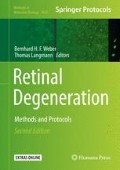Abstract
The functionalization of nanoparticles with specific receptor ligands enables their accumulation in targeted tissues and can be used therapeutically to transport drugs or for diagnostic purposes (Parveen et al., Nanomedicine 8:147–166, 2012). We could recently show that targeting endothelial cells in retinal and choroidal capillaries can be realized even under physiological conditions using quantum dots as model nanoparticles functionalized with an integrin-binding peptide (Pollinger et al., Proc Natl Acad Sci 110:6115–6120, 2013). Even though the chemistry that we used was well described in the literature and may be considered standard for the purpose, there are a number of preparation steps that are delicate and deserve special attention. It is, therefore, our intention to describe step by step the critical methods of ligand immobilization on quantum dot surfaces to facilitate the reader to reproduce our work. Here we describe the chemical modification of quantum dots with c(RGDfC) as targeting peptide that allows the resulting modified nanoparticles to adhere to endothelial cells also in the retinal tissue. We illustrate the properties of the resulting particles by showing some of the in vitro results from our previous studies. Doing so, we concomitantly encourage the reader to check particles intended for targeting cells in vivo first by extensive in vitro analysis of particle interaction with cells by the means of flow cytometry and confocal microscopy to confirm the successful functionalization. Only then the application of functionalized quantum dots into the systemic circulation of mice led to the desired localization of nanoparticles in the retinal and choroidal blood vessels (Pollinger et al., Proc Natl Acad Sci 110:6115–6120, 2013).
Access this chapter
Tax calculation will be finalised at checkout
Purchases are for personal use only
References
Giuliari GP (2012) Diabetic retinopathy: current and new treatment options. Curr Diabetes Rev 8:32–41. https://doi.org/10.2174/157339912798829188
Kumar B, Gupta SK, Saxena R, Srivastava S (2012) Current trends in the pharmacotherapy of diabetic retinopathy. J Postgrad Med 58:132. https://doi.org/10.4103/0022-3859.97176
Avery RL, Pieramici DJ, Rabena MD et al (2006) Intravitreal bevacizumab (avastin) for neovascular age-related macular degeneration. Ophthalmology 113:363–372.e5. https://doi.org/10.1016/j.ophtha.2005.11.019
Maeshima K, Utsugi-Sutoh N, Otani T, Kishi S (2004) Progressive enlargement of scattered photocoagulation scars in diabetic retinopathy. Retina 24:507–511
Martidis A, Duker JS, Greenberg PB et al (2002) Intravitreal triamcinolone for refractory diabetic macular edema. Ophthalmology 109:920–927. https://doi.org/10.1016/S0161-6420(02)00975-2
Moshfeghi DM, Kaiser PK, Scott IU et al (2003) Acute endophthalmitis following intravitreal triamcinolone acetonide injection. Am J Ophthalmol 136:791–796. https://doi.org/10.1016/S0002-9394(03)00483-5
Grunwald JE, Daniel E, Huang J et al (2014) Risk of geographic atrophy in the comparison of age-related macular degeneration treatments trials. Ophthalmology 121:150–161. https://doi.org/10.1016/j.ophtha.2013.08.015
Campbell ID, Humphries MJ (2011) Integrin structure, activation, and interactions. Cold Spring Harb Perspect Biol 3:a004994. https://doi.org/10.1101/cshperspect.a004994
Singh SR, Grossniklaus HE, Kang SJ et al (2009) Intravenous transferrin, RGD peptide and dual-targeted nanoparticles enhance anti-VEGF intraceptor gene delivery to laser-induced CNV. Gene Ther 16:645–659. https://doi.org/10.1038/gt.2008.185
Salehi-Had H, Roh MI, Giani A et al (2011) Utilizing targeted gene therapy with nanoparticles binding alpha v Beta 3 for imaging and treating Choroidal neovascularization. PLoS One 6:e18864. https://doi.org/10.1371/journal.pone.0018864
Krzystolik MG, Afshari MA, Adamis AP et al (2002) Prevention of experimental Choroidal neovascularization with Intravitreal anti–vascular endothelial growth factor antibody fragment. Arch Ophthalmol 120:338–346. https://doi.org/10.1001/archopht.120.3.338
Spilsbury K, Garrett KL, Shen W-Y et al (2000) Overexpression of vascular endothelial growth factor (VEGF) in the retinal pigment epithelium leads to the development of Choroidal neovascularization. Am J Pathol 157:135–144. https://doi.org/10.1016/S0002-9440(10)64525-7
Yoshida T, Gong J, Xu Z et al (2012) Inhibition of pathological retinal angiogenesis by the integrin αvβ3 antagonist tetraiodothyroacetic acid (tetrac). Exp Eye Res 94:41–48. https://doi.org/10.1016/j.exer.2011.11.003
Pollinger K, Hennig R, Ohlmann A et al (2013) Ligand-functionalized nanoparticles target endothelial cells in retinal capillaries after systemic application. Proc Natl Acad Sci 110:6115–6120. https://doi.org/10.1073/pnas.1220281110
Jacot JL, Sredy J (1999) Emerging therapeutics for diabetic retinopathy: potential therapies for the new millennium. Emerg Therap Targets 3:307–335. https://doi.org/10.1517/14728222.3.2.307
Hild WA, Breunig M, Goepferich A (2008) Quantum dots - nano-sized probes for the exploration of cellular and intracellular targeting. Eur J Pharm Biopharm 68:153–168. https://doi.org/10.1016/j.ejpb.2007.06.009
Walling MA, Novak JA, Shepard JRE (2009) Quantum dots for live cell and in vivo imaging. Int J Mol Sci 10:441–491. https://doi.org/10.3390/ijms10020441
Johnson ID (2010) The molecular probes handbook: a guide to fluorescent probes and labeling technologies, 11th edn. Life Technologies Corporation, Carlsbad, CA
Aumailley M, Gurrath M, Müller G et al (1991) Arg-Gly-Asp constrained within cyclic pentapoptides strong and selective inhibitors of cell adhesion to vitronectin and laminin fragment P1. FEBS Lett 291:50–54. https://doi.org/10.1016/0014-5793(91)81101-D
Pfaff M, Tangemann K, Müller B et al (1994) Selective recognition of cyclic RGD peptides of NMR defined conformation by alpha IIb beta 3, alpha V beta 3, and alpha 5 beta 1 integrins. J Biol Chem 269:20233–20238
Cai W, Chen X (2008) Preparation of peptide-conjugated quantum dots for tumor vasculature-targeted imaging. Nat Protoc 3:89–96. https://doi.org/10.1038/nprot.2007.478
Shi W, Bartlett JS (2003) RGD inclusion in VP3 provides Adeno-associated virus type 2 (AAV2)-based vectors with a heparan sulfate-independent cell entry mechanism. Mol Ther 7:515–525. https://doi.org/10.1016/S1525-0016(03)00042-X
Acknowledgments
This work was supported by Deutsche Forschungsgemeinschaft Grant GO565/17-1 and Teilprojekt 7 of Research Unit (Forschergruppe) 1075.
Author information
Authors and Affiliations
Corresponding author
Editor information
Editors and Affiliations
Rights and permissions
Copyright information
© 2019 Springer Science+Business Media, LLC, part of Springer Nature
About this protocol
Cite this protocol
Haunberger, A., Goepferich, A. (2019). Nanoparticles Targeting Retinal and Choroidal Capillaries In Vivo. In: Weber, B.H.F., Langmann, T. (eds) Retinal Degeneration. Methods in Molecular Biology, vol 1834. Humana, New York, NY. https://doi.org/10.1007/978-1-4939-8669-9_25
Download citation
DOI: https://doi.org/10.1007/978-1-4939-8669-9_25
Publisher Name: Humana, New York, NY
Print ISBN: 978-1-4939-8668-2
Online ISBN: 978-1-4939-8669-9
eBook Packages: Springer Protocols

